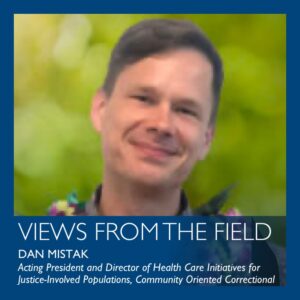Dan Mistak, Acting President and Director of Health Care Initiatives for Justice-Involved Populations,
Community Oriented Correctional Health Services
In February of 2020, Community Oriented Correctional Health Services (COCHS) knew that that a recently named novel virus was going to prove the central thesis of our mission: that public health and public safety are inextricably entwined. Early in the pandemic, we sketched out the ways in which the criminal-legal system would need to engage with the public health systems in order to create solutions for those stuck behind the walls of the jail. COCHS lent its expertise to jurisdictions as they crafted emergency Medicaid waivers, requested technical assistance to convene community providers, and ran through the litany of non-pharmaceutical interventions that could prevent the virus’ spread while incarcerated and during decarceration. Throughout this process, we witnessed what happens when discrete health systems ignore the reality that the health of people on both sides of the bars are intimately tied. Now, with these lessons in hand, we have the opportunity to build better systems that respond to the critical health needs of incarcerated individuals, while simultaneously remedying the historical wrongs that create disparate impacts in our health and criminal legal systems.
COVID-19 hit jails and prisons particularly hard. Under normal conditions, carceral settings are ideal environments for infectious disease spread. Due to the massive overcrowding of jails and prisons, these sites serve as loci of outbreaks that cannot be contained. In the early days of COVID-19, one in six cases in Illinois could be traced back to the Cook County Detention Center. In December, a study from Prison Policy Initiative revealed that over 500,000 cases could be traced back to out-of-control spread at correctional facilities. If it were not clear to policymakers before, COVID-19 demanded careful reexamination of how public health agencies incorporate correctional facilities into their public health planning.
The disparities continued as states weighed which populations should be prioritized for vaccines. Many classified people in jails and prisons differently from people in living facilities. For example, Colorado initially placed incarcerated people into priority categories, but after facing public backlash, deprioritized these individuals, despite the science targeting high-risk settings remaining the same. Even to this day, as variant waves sweep through facilities and vaccine uptake is low, people in jail and prison are often falsely seen as being uniquely unreachable through public health interventions, such as peer support and learning from friends and family about why to vaccinate.
COVID-19 has had disproportionate impact on justice-involved people because health and justice systems maintain discrete siloes due to longstanding policies. These policies create structural barriers to an integrated response to people living at the intersection of these two systems. Federal law does not allow for an individual who is incarcerated to receive Medicaid services, even though they may be otherwise eligible. The so-called “inmate exclusion” has meant that at people’s most challenging times, they lose access to the services and drug formularies that they may need. This shifts the burden of providing health care services to local correctional health systems that have no incentive to connect in with the broader health care systems. Over time, these systems have evolved in ways that exacerbate the disparities as people churn between one system to the other. COVID-19 revealed that although there are clear health and policy reasons to focus on the health conditions in carceral settings, underinvestment, residual prejudices, and political expediency stand in the way of making lasting changes. Maintaining a separate health care system for people in jails and prisons has ensured disparate outcomes for these individuals and the communities that they come from.
There is light on the horizon that suggests things will improve at the intersection of health and justice. A new law passed as a part of the American Recovery Plan allows for the creation of Medicaid-funded mobile crisis services that can help people in crisis avoid jail admissions. Responding to the need for investment in COVID-19 mitigation strategies in carceral settings, the Centers for Disease Control is earmarking $700 million for testing in carceral settings as well as supporting public health interventions aimed at reducing the number of people in these facilities. The National Academies of Science recommended decarceration as an essential tool for stopping the transmission of COVID-19. Unfortunately, even in jurisdictions that reduced their jail census at the beginning of the pandemic, the number of people who are reincarcerated has crept back up, many times due to technical violations rather than actual criminal behavior.
Besides funds for decarceration and policies to build sustainable crisis systems, policymakers are reexamining the structural barriers that limit the ability of jurisdictions to create Medicaid-supported systems while incarcerated. There are several bills in Congress that tackle the so-called Medicaid inmate exclusion. These bills have received a wide range of support from the National Sheriff’s Association to the American Medical Association. It is clear that momentum has shifted towards changes to this policy. Finding a suitable vehicle to pass this otherwise popular bill remains a priority for many advocates and those working on the Hill. The question is whether or not historically underfunded and unintegrated community systems will be ready to answer the call.
Focusing resources in this overlooked area provides an excellent opportunity for a return on investment for grantmakers seeking to make impactful change. More investment in this important time is necessary, and the opportunity for meaningful interventions is vast. Work with community providers to improve their access to Medicaid funding sources will poise these providers to reach in to jails and prisons in ways that will improve outcomes for both the criminal legal and health systems. Improving public safety’s engagement with public health systems will remedy historic wrongs, meet the present challenges, and shape a more equitable system that ensures high-quality care wherever people receive services.

